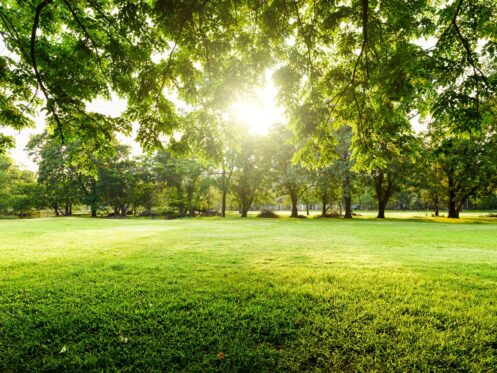Spring is a great time to fertilize your trees. As the temperatures start to get warmer, trees go into their active growth phase. It’s during this time that they need vital nutrients to develop strong roots and lush foliage. Adding tree fertilizer during the spring replenishes all the nutrients they lost during the winter.
What Is Tree Fertilization?
Tree fertilization is a process that involves adding essential nutrients to trees. Much like a human needs a balanced diet to have energy and stay healthy, trees need nitrogen, phosphorus, and potassium support. Fertilizers act as supplements for these must-have nutrients. Trees that receive regular fertilization enjoy better growth and are more resistant to certain diseases.
Fertilizing trees, whether using compost or commercially available specialty fertilizers, is essential for a flourishing landscape. With regular fertilization, the trees in your yard will develop deep root systems and vibrant foliage and blooms.
Benefits of Tree Fertilization
Fertilization fortifies trees by making them more resilient to diseases, pests, and other environmental stresses. It improves the aesthetic value of landscapes by making them seem livelier and healthier. Here’s a closer look at the many benefits of tree fertilization.
Like a Multivitamin for Your Trees
Trees can’t grow healthy and sturdy without the nutrients provided by fertilizer. Trees with proper nutrition have a much lower risk of limb weakness and breaking; this proves to be of the utmost advantage during storms with strong winds and rain. Strongly constructed trees can even save money in the long run, as they require less trimming and upkeep.
Healthier Ecosystem for Your Lawn
Healthy root growth is a key component of tree stability, and healthy nutrition with fertilization helps plants achieve this. Shade, oxygen, and a place for animals to call home are just a few ways that healthy trees help maintain healthy ecosystems.
Reduces Pest Control Issues
When trees lack essential nutrients, they become stressed, making them more vulnerable to pest infestations. Healthier trees build a natural resistance to pests like borers and aphids. The fertilization strengthens the trees’ immune systems, making them less attractive to harmful insects. Trees that receive fertilization also develop the ability to recover from pest damage quickly. This can reduce the need for chemical pest control treatments that may cause more harm than good.
Helps Avoid Environmental Damage
Fertilizing trees enhances soil quality by replenishing essential nutrients. It also has the benefit of reducing soil compaction, allowing roots to absorb more water and oxygen. This, in turn, helps avoid a host of environmental problems. The promotion of deep root development in nutrient-rich soil stabilizes the ground and lowers soil displacement, hence preventing erosion. A lesser chance of water runoff, which can introduce contaminants into local water sources, is another benefit.
Enhances Aesthetics and Beauty of Landscaping
With its healthy growth, vibrant blossoms, and sturdy limbs, a well-nourished tree enhances the visual appeal of any yard. If you ever decide to put your house on the market, a well-kept yard will be one of the first things prospective buyers notice. In addition to providing shade, trees adorned with vibrant blossoms create stunning outdoor spaces for entertaining, such as garden parties, family barbecues, outdoor weddings, and backyard picnics.
Why Spring Is the Best Time to Fertilize Trees
Trees are highly receptive to supplemental nutrients in the spring when they begin their development cycle and emerge from winter dormancy. This is when they start producing new leaves, blossoms, and fruit, which means they need more nutrients. Fertilizing at this time provides them with the boost they need to develop thick leaves and sturdy roots.
Should You Refertilize in the Fall?
For healthy root development and continued tree health all winter, autumn refertilization is a must. The trees enter a dormant phase when the weather becomes colder; this is when they allocate all their energy to growing their roots instead of producing new leaves. Nitrogen, phosphorus, and potassium are three of the most important nutrients that the trees need. Applying fertilizer enriched with these nutrients in the autumn gives the trees a head start on a healthy spring. Autumn fertilization also leads to increased resilience to disease and better water and nutrient absorption.
What Are the Best Types of Tree Fertilizers?
Each tree has different nutritional requirements; therefore, choosing the right fertilizer is important. Organic fertilizers, such as mulch or compost, gradually release nutrients into the soil, which is beneficial for native trees in Christiansburg, VA. Locally adapted species rely on these nutrients to build soil structure and retain moisture. To ensure your ornamental trees have healthy, beautiful leaves and flowers, they require a fertilizer with a balanced mixture of nitrogen, phosphorus, and potassium.
Should You Use DIY or Professional Tree Fertilization?
If you want to fertilize your tree on your own, you can use granular or liquid fertilizers and apply them along the drip line. Expert fertilization services, however, use deep root feeding methods to precisely apply nutrients. This ensures optimal absorption and promotes strong root development. Additionally, expert arborists understand how to evaluate soil quality and select the appropriate fertilizer to maintain tree health.
Helpful Tips for Using Tree Fertilization
There are two main tips you should use when fertilizing trees: always get the soil tested and use proper application techniques. You risk nutrient imbalances and potential root damage if you don’t follow these tips.
Always Get the Soil Tested First
To make sure trees get the right fertilizer, soil testing checks for pH levels and nutritional deficiencies. This testing is particularly useful in Virginia, as different trees have varying requirements due to the state’s diverse topography. Without proper testing, certain fertilizers might cause stunted growth and other concerns. Homeowners can consult with our experts and set up a soil and pH test for their lawns.
Depending on the lab, soil testing may take anywhere from one to two weeks to complete. This phase involves testing the sample for nutritional content, acidity/base balance, and any inadequacies. You will receive a comprehensive report with suggestions for enhancing soil health to support ideal tree development once the findings are available.
Use Proper Application Techniques
Trees become more vulnerable to disease and structural problems when they experience quick, feeble growth due to over-fertilization. For optimal nitrogen uptake by the tree’s roots, it is very important to apply fertilizer evenly across the drip line. Deep root injection is a common method used by professionals to ensure rapid absorption of nutrients. This method delivers the nutrients straight to the root zone. Avoiding over-fertilization is also crucial for preventing fertilizer runoff, which is harmful to aquatic life and adjacent plants.
All Natural Tree Experts is here to answer any questions you may have about tree fertilization. We provide arborist consultations, tree planting, soil care, insect and disease management, and so much more. Our No. 1 goal is to help you create stunning landscapes that are healthy year-round.
Contact All Natural Tree Experts now to learn more about tree fertilization in Christiansburg.


